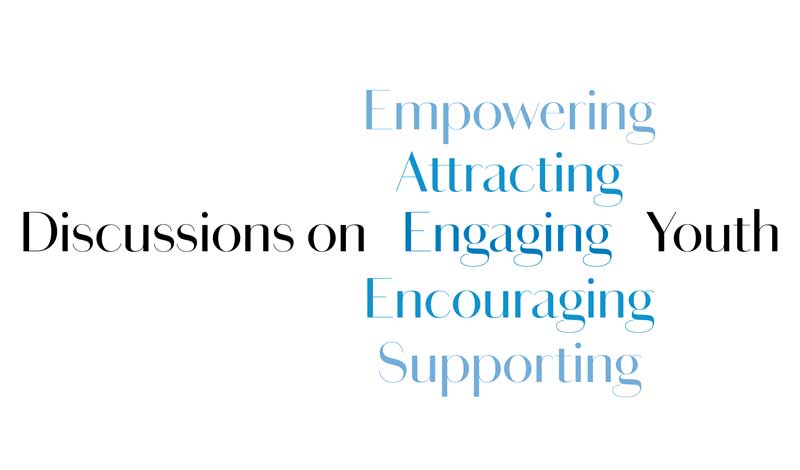What challenges do you find when introducing your friends to Buddhism or inviting them to a discussion meeting?” In a recent survey, SGI-USA youth division members were asked this question. At the top of the list: “Many of my friends don’t like organized religion or religious communities.”
While the reasons for this response varied, the purpose of our practice of Nichiren Buddhism and the role that the SGI plays in helping young people become capable remains the same.
If we look at the Latin root of the word religion, re means “again,” as in the words revisit or resume. Lig means “to bind or connect,” like a ligament in your leg. So, based on its Latin root, religion means to connect yourself to that which is fundamental, again and again.
The original meaning of the word religion also serves as the core tenet of our Buddhist practice—that religion exists to help people to become absolutely happy. And the Soka Gakkai exists to show people how to bring out this absolute happiness, or innate enlightened condition, again and again, amid the challenges of our daily lives.
By chanting Nam-myoho-renge-kyo, we tap limitless reserves of wisdom, courage and compassion from within and apply them to our daily lives. As a result, we can change ourselves on the most basic level, which in turn transforms our environment.
Second Soka Gakkai President Josei Toda called this process human revolution. But for people to know about this life-changing philosophy, someone has to tell them about it.
After being released from prison in 1945, second Soka Gakkai President Josei Toda emerged to find Japan and its people devastated by war, sickness and famine. Having been wrongly persecuted by the militarist authorities and having to endure the anguish of the death of his mentor, first Soka Gakkai President Tsunesaburo Makiguchi in prison, President Toda vowed to promote a continued active, socially engaged Buddhist community as a means of self-empowerment. Alongside his disciple, Daisaku Ikeda, they rebuilt the Soka Gakkai to a membership of over 750,000 households by the time of Mr. Toda’s passing in 1958. As third Soka Gakkai President, Ikeda Sensei globalized Nichiren Buddhism, leading its spread to 192 countries and territories.
How was this accomplished? It was through building bonds of trust and friendship. Sensei states:
Nichiren Daishonin writes of a “friend in the orchid room” (“On Establishing the Correct Teaching,” The Writings of Nichiren Daishonin, vol. 1, p. 23). This expression means that, just as orchids in a room impart their exquisite fragrance to all who enter, we should strive to be the kind of friend who has a positive and uplifting effect on others. (Discussions on Youth, p. 48)
When we think about how we each began practicing, it can often be traced back to a friend, family member or acquaintance we trusted, who had the courage to talk to us about Nichiren Buddhism and invited us to a discussion meeting. In most cases that process didn’t take hold overnight. We may have been skeptical of religion, religious organizations and those who promote them, for many of the same reasons the youth expressed in the survey. But eventually, we began to practice, because our good Buddhist friends stuck with us through good and bad times, when others often disappeared from our lives.
The Soka Gakkai organization exists to cultivate these bonds of trust and friendship for the sake of kosen-rufu, to create a peaceful world.
Sensei states:
The organization of the Soka Gakkai emerged naturally from that spirit—the spirit to somehow encourage another person, to want to see others become happy. The Soka Gakkai didn’t appear first and then become filled with people. People began forging bonds with one another, and then those ties of friendship spread, naturally giving birth to the Soka Gakkai organization. For that reason, we must be aware that the organization exists for people. People don’t exist for the organization. Please never forget this point. (DOY, 240)
Sensei goes on to explain the importance of an organization, especially when it involves our mission to achieve kosen-rufu:
Everything is an organization. When a couple unites to create a happy family, they are quite naturally forming an organization. Then there is the invisible organizational framework that we find exists within our local communities, where communication has become a vital key in maintaining good relations with friends and neighbors. You are in some way connected to everything around you—to society, school, your family and so on. Everyone is part of some kind of organization. No one in today’s world, except perhaps a hermit living on a remote mountain somewhere, is exempt. It is only natural, therefore, when we seek to achieve a great objective or to develop ourselves so that we can make great accomplishments, that some sort of organization is essential. The Soka Gakkai is an organization working to realize the great objective of kosen-rufu—of achieving peace and happiness for all humanity based on the principles and philosophy of Nichiren Buddhism. Such an objective cannot be accomplished through the efforts of one person alone. It becomes possible only when people in various spheres of society come together, organize themselves into a cohesive force and work to achieve that goal. (DOY, 240)
We are all so fortunate to be a part of the SGI community of building trust and friendship among people through this practice of Nichiren Buddhism. But, this movement can only advance if, as disciples of Ikeda Sensei, we take courageous action to expand our circle of friendships, share this wonderful practice and invite those in our environment to our Buddhist community.
In the April 11, 2025, World Tribune, the national youth team created a motto, born from the question of what the next steps should be after gathering more than 3,000 youth guests at our March district discussion meetings:
Creating a District With Many Youth Is Up to Me.
It’s time to overcome our fears and reservations, and unite with our youth members in befriending the young people around us and inviting them to a discussion meeting. It’s up to me! Let this be our shared spirit.
Let Us Know How It’s Going!
Drop us a line or two on how your effort to introduce young people to the practice is going! Email us at: wt@sgi-usa.org with the subject line: Up to Me.
May 3, 2025 World Tribune, pp. 6–7
You are reading {{ meterCount }} of {{ meterMax }} free premium articles

